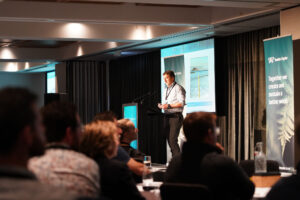Thanks for all your questions during the webinar hosted by Tonkin + Taylor and Informed.Cities on Transition Planning and climate-related disclosures. Our experts, Simon Harvey, James Hughes, and Ian Edwards, have answered the questions whilst pointing to some additional resources.
Resilience vs Transformation – Why do you refer to resilience rather than transformation, as the desired outcome?
Transformation represents a pathway to resilience. Simply without transforming from current to resilience, a resilient state cannot be achieved. It is interesting that you adopt the term “transformation” as opposed to “transition”. There is of course a significant distinction between the two where “transformation” reflects a fundamental immediate shift from one state to another while “transition” ultimately achieves the same objective but in incremental steps. To a large degree the results of your risk assessment, tolerance and ambition will determine whether your company transitions or transforms. Having said that, given how late in the game we are, it’s not probable to envision maintaining temperatures anywhere near the goal of 1.5°C without transformative change.
Approach to Integrating Risk Assessments – Can you explain the relationship between entity level risk assessments and transition planning?
Transition planning is a process driven predominantly (like any plan) by actions organised by prioritisation, dependency, resource availability and ambition. The objective of the plan is to position the entity to minimise any negative implications of climate-related drivers and position it to be able to leverage/harness those same drivers for its own benefit (my loose definition of “resilience”). The objective of a risk assessment is to identify risks that climate drivers generate for an entity and assess these risks by their potential magnitude and certainty.
The results of a risk assessment combined with cost-benefit considerations inform which risks will be managed, how they will be managed and in what order of priority (i.e when). These are important inputs to a transition plan. However, they are not the only ones. For example, prioritisation of actions will also be dictated by the ambition of the entity (e.g. does it want to be a leader, fast follower etc) and option outcomes of scenario analysis can help identify low hanging fruit and no-regrets changes. To maximise its resilience, an entity will also need the flexibility to identify and respond to novel risks as they emerge – the earlier it can do this, the better (minimise impacts, maximise competitive advantage). This is essentially risk assessment on the fly which can be enabled through, for example, integration of climate considerations into entity functions and processes – a critical outcome of transition planning.
How to Make Progress if Scope 3 Data is Not Yet Complete
How can we have a transition plan without having yet baselined all of our scope 3 emissions (given data limitations and lack of guidance in certain material areas). We can talk about our responses to climate risks and opportunities, but won’t have any meaningful scope 3 emissions reduction targets for a few years. Does this suffice?
A transition plan can still be commenced, focussing on scope 1, scope 2, and responding to risks and opportunities. These are issues within the direct control of an organisation. Over time, an organisation can gather data and begin to address scope 3 challenges.
Reliance on Others to Make Progress – What is your plan is dependant on government actions or technological innovations occuring?
Many organisations will be in this situation. Ultimately, this will relate to the organisation’s ambition regarding decarbonisation. It will also depend on how much the organisation chooses to align this ambition with technical feasibility, whilst considering the urgency of change required for carbon reduction and other material sustainability issues. All of this must fit within the organisation’s overall business strategy.

Integrating Management of Multiple Issues into Asset Operation and Management Strategy
How can asset operation and management strategies integrate emissions reduction, resilience and sustainability principles to maximize long-term return on investment while balancing efficiency and compliance with climate goals?
By considering them holistically. A reductionist approach, where each is considered in isolation of the others, risks in the best case neglecting synergies and in the worst, suboptimal outcomes (e.g. address one or some goals to the detriment of others) that need to be subsequently rolled back and reconsidered – hardly an efficient use of resource. For example, in setting emissions reductions goals, entities should ensure that they have considered how subsequent decarbonisation actions will impact other objectives. Such an informed approach will identify negative impacts that can be subsequently addressed, and highlight where actions could be extended/tweaked to address other objectives also.
Sometimes, there may be no practical way to achieve one goal (e.g. climate goals) without negatively impacting others (e.g. resilience vs efficiency can sometimes be in tension). In such circumstances, a wholistic approach will ensure that trade-offs are founded on informed decisions not as a result of unintended consequences.
Dynamic and Adaptive Planning – What is a good example of DAPP applied in a strategy context?
Dynamic Adaptive Pathways Planning, or Flexible Pathways, or Adaptive Management are all similar concepts and most literature exists around their use in response to uncertainty in the biophysical world (climate, environment etc), as well as during the COVID pandemic. These ideas are applicable for business strategy as well – again, particularly where there are high degrees of uncertainty. For more information, there’s a good discussion here https://hbr.org/1997/11/strategy-under-uncertainty.
Involving Legal Advice in CRDS – How do we navigate legal concerns and involvement of lawyers related to CRD, its seems to reduce positive outcomes of CRDS?
Directors have personal liability for statements in CRDs under New Zealand’s Financial Markets Conduct Act, meaning they must ensure the disclosures are accurate, reasonable, and backed by robust evidence. Navigating that situation prudently can involve:
- Strategic legal input: Involve lawyers early for compliance guidance, ensuring their role supports rather than dominates the CRD process.
- Strong governance: Develop robust accountability and assurance processes to ensure accurate and defensible disclosures.
- Transparent efforts: To maintain trust, prioritise good faith, transparent disclosures rather than overly-sanitised disclosures.
- Purpose-driven focus: Use CRDs to align with long-term strategy, balancing legal risks with positive sustainability outcomes.
Stand-alone Vs Integrated Reporting Approach for Transition Plan Disclosures
What are your thoughts on stand-alone documents vs integrated transition plans in our CRD (and then AR reporting from next year)? And how much level of detail should be included in our CRD? The TPT framework is very detailed and I can’t imagine bulking out already large documents to the full extent recommended in some of the frameworks.
Integrated transition plans within CRDs and annual reports can help show how climate strategy aligns with broader business objectives, avoiding duplication and fostering a cohesive narrative. Stand-alone documents can complement this by providing more detailed technical or operational insights for specific audiences.
For level of detail, focus on materiality – what’s most relevant to stakeholders and critical for decision-making. The Transition Planning Taskforce framework is valuable, but it’s not necessary to include every element. Prioritise the most useful insights, supported by links or references to more detailed appendices or online resources where that adds value. This will help manage document size while maintaining transparency and compliance.

Ambition Targets and Greenwashing
Both ambition and achievability are critical, but they need to be balanced. You might outline a science-aligned ambition to show leadership and credibility, framing it as the long-term desired destination. Then, clearly define near-term goals that are actionable and within your sphere of influence as steps towards that longer-term ambition. Transparency about the gap between ambition and current capabilities is important – acknowledging dependencies on the need for broader systemic change will address greenwashing risk while maintaining integrity and fostering trust. In other jurisdictions, investors have indicated they want to see more ambition in transition planning, as indicated in this report by Lloyds Bank, based on a survey of corporates and investors in the UK.
Sunset Industries and Businesses – What if it has been determined that the strategy identifies that a business will not exist in the next 50 years?
If the long-term strategy indicates redundancy of a particular business in the longer-term future, focusing on a responsible transition is paramount. The business can emphasise near and medium-term value creation while investing in innovation, diversification, and workforce reskilling to adapt to emerging technologies. Be transparent about the strategic horizon, ensuring stakeholders understand the plan to manage risks, seize opportunities, and contribute positively during the transition period.
Shift Towards Credibility of Targets and Transmission Plans – Moving away from emission targets towards alignment and credibility of transmission plans
The document that I referred to is the SBTi’s Financial Institutions Net-Zero Standard Consultation Draft V0.1 released in July 2024. The document marks a more principles-based approach to target-setting where financiers determine priority based on the influence and impact of their financial activities. Section 3 runs through the development of portfolio alignment targets. Note that the SBTi still require that firms still establish GHG emission inventories over time. Portfolio alignment targets provide a pragmatic approach to get started without the overhead of what is essentially a lagging indicator.






















